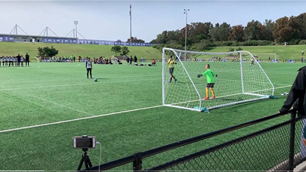Sadly, the demise of Gold Coast United spells the end of the M1 Derby too.
As a would-be bohemian sophisticate, albeit with admittedly questionable taste, I’ve convinced myself over the years that there is beauty to be found in even the most gritty of settings.
I have, perhaps against my better judgement, pirouetted perilously around putrid puddles of piss just so I may appreciate the scrawlings on public toilet walls; enthusiastically elbowed my way through sweaty, seething seas of societal misfits at shambolic punk-rock shows; and even found melancholic meaning deep within the crumbling concrete corridors of abandoned buildings.
Yet strangely, all this grittiness pales in comparison to the gritty determination on display at Skilled Park last weekend – not just from the players but from both sets of supporters as well.
Now, I say strangely since, before Sunday’s match, the only grit I envisaged on the so-called ‘glitter strip’ was the coarse sensation of beach sand inadvertently souvenired between the buttocks of swimmers, surfers and sunbathers.
However, I must now admit that I was mistaken. That there was a tenacious, fighting spirit on display at Gold Coast United’s home ground Sunday evening, a grittiness that’s unlikely to be seen in these parts again for many years.
Firstly, there were the players. The youngsters in yellow, wooden-spoon winners and well aware their club could be playing its last competitive fixture, jostled and lunged for every loose ball and half chance like it was a final.
They celebrated like champions when they opened the scoring through Daniel Bowles, and they felt the pain of damning defeat so acutely it belied, but not to their discredit, their otherwise outstanding professionalism in trying circumstances.
Meanwhile those in black, confirmed as league runners-up hours earlier and comprised of youth team standouts and squad players desperate for a chance, scrapped like the lions on their club crest despite the season’s premier prize being out of reach.
And they eventually got their reward, a first ever win on the Gold Coast, with two first time goal scorers in Nick Fitzgerald and George Lambadaridis claiming the glory but all in the squad playing a part in delivering it.
And, of course, both sides were cheered on by their supporters. There were those in ‘The Beach’, their banners pleading with the federation for an unlikely stay of execution, their unified voice defending their club ‘til the very last minute.
Meanwhile, directly opposite, was an orange-clad den of travelling Brisbanites, containing Roar’s three main active supporter groups, significantly outnumbering and easily outchanting their southern counterparts.
It was a gritty yet beautiful spectacle that not even a few over-zealous police officers could ruin. It made me regret not having travelled to watch my club at the home of their fiercest rivals before. And it made me regret further that I shall never have the opportunity to do so again.
Of course, Football Federation Australia are yet to confirm it, but reading between the lines it’s increasingly apparent that Gold Coast United will not return to the A-League next season and, as such, neither will the M1 Derby.
In my opinion, this is the saddest facet of the once glamourous club’s impending demise.
While other A-League clubs have died before – and I say this with all due respect to both Fury and Knights supporters – the death of a derby holds much more significance since it ultimately affects two clubs, two cities and two fanbases.
It will be difficult for Roar supporters to return to our inaugural rivalry with Sydney FC with the same verve that accompanied that with Gold Coast United. And it will certainly become farcical to try if a Western Sydney franchise enters the league in United’s stead.
After all, there can be no rivalry if the other side refuses to recognise it as such.
Meanwhile, Boxing Day, a traditional time of battle, will cease to hold meaning to those, like me, whose only religious devotion is to their football club. While the certain to be revived rivalry round will have to plug yet another square peg into a round hole as it already attempts with Wellington, Adelaide and Perth.
Sure, there will still be matches with other clubs that will take on near mythic proportions; finals fixtures will still be keenly contested for 90 minutes or more. But these will nearly certainly be examples of finer football, lacking the good ol’-fashioned grit of a match between two local rivals, with nothing to play for but pride.
It’s for this reason that clubs, both big and small, need their derbies. They allow a chance of redemption in what might be otherwise forgettable campaigns. And, in a country as geographically problematic as Australia, it provides the only genuine opportunity for two opposing ends to chant in near even numbers.
But alas, that is all soon to be gone. No more trips up and down the freeway for either set of supporters. No more macho posturing by blowhards outside the stadium before and after the match. No more M1 Derby, period!
It may not have been the largest derby in the league, and it may well be replaced by a Sydney derby that makes it look piddly and provincial by comparison. But it was still ours and we loved it. And what’s more, it had grit.
Now, the only grit that remains is the gritting of teeth as the sense of loss turns to frustration and, ultimately, unresolvable anger.
It may be unbohemian and unsophisticated to show that one cares about something as allegedly futile as football, but as a Roar supporter I will regret the death of the M1 Derby – a contest whose beauty was all too apparent and whose presence was far too fleeting.
Related Articles

Fresh talent flock to ambitious A-League outfit's pro pathway

Why A-League 20/21 is crucial for Olyroos’ medal hopes













